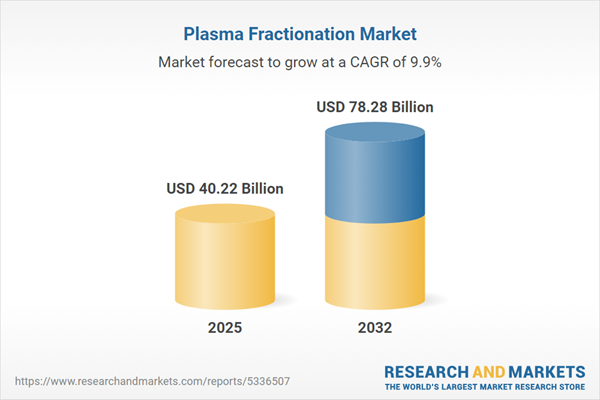Speak directly to the analyst to clarify any post sales queries you may have.
The plasma fractionation market is undergoing marked transformation, fueled by advanced technologies and shifting healthcare priorities. Senior leaders navigating this sector must recognize dynamic regulatory, trade, and innovation trends shaping supply, demand, and competitive advantage.
Market Snapshot: Growth Trajectory and Strategic Landscape
The Plasma Fractionation Market grew from USD 36.77 billion in 2024 to USD 40.22 billion in 2025. It is expected to continue growing at a CAGR of 9.90%, reaching USD 78.28 billion by 2032. This progression highlights ongoing demand for plasma-derived therapeutics, sustained investment in infrastructure, and a global push toward advanced purification and manufacturing approaches. Decision-makers are responding to rising requirements for high-purity products across hematology, immunology, and neurology, positioning the market for further innovation and expansion.
Scope & Segmentation
- Product Type: Albumin, Coagulation Factor Concentrates, Intravenous Immunoglobulin, Subcutaneous Immunoglobulin, Protease Inhibitors
- Method of Fractionation: Centrifugation, Cryoprecipitation, Ethanol Precipitation, Ion-Exchange Chromatography, Ultrafiltration
- Application: Hematology, Neurology, Oncology, Rheumatology
- End-User: Academic Institutions, Clinical Research Laboratories, Hospitals & Clinics
- Regions: Americas (United States, Canada, Mexico, Brazil, Argentina, Chile, Colombia, Peru), Europe (United Kingdom, Germany, France, Russia, Italy, Spain, Netherlands, Sweden, Poland, Switzerland), Middle East (United Arab Emirates, Saudi Arabia, Qatar, Turkey, Israel), Africa (South Africa, Nigeria, Egypt, Kenya), Asia Pacific (China, India, Japan, Australia, South Korea, Indonesia, Thailand, Malaysia, Singapore, Taiwan)
- Companies: 3M Company, ADMA Biologics, Inc., Bharat Serums and Vaccines Limited, Bio Products Laboratory Ltd., Biotest AG by Grifols, S.A., China Biologic Products, Inc., CSL Limited, Emergent BioSolutions Inc., GC Biopharma corp., HEINKEL Process Technology GmbH, Hemarus Therapeutics Ltd, Intas Pharmaceuticals Ltd., Kamada Ltd., Kedrion S.p.A., LFB SA, Merck KGaA, Octapharma AG, PlasmaGen BioSciences Pvt. Ltd., Prothya Biosolutions B.V., Shanghai Raas Blood Products Co. Ltd., SK Plasma Co.,Ltd., STERIS plc, Takeda Pharmaceutical Company Ltd.
Key Takeaways for Senior Decision-Makers
- Technological advancements such as continuous processing and advanced chromatography are streamlining production and boosting product availability.
- Global regulatory agencies have moved toward harmonized frameworks, shortening approval timelines and enhancing traceability standards for plasma-derived therapies.
- Personalized medicine and immunotherapy trends are triggering demand for new immunoglobulin formulations and greater application diversity.
- Companies are scaling operational capacity by adopting hybrid and membrane-based fractionation workflows, responding to clinical complexity and diverse patient needs.
- Collaboration with research institutes and supply chain partners is critical to foster innovation, improve access, and help navigate shifting market risks.
Tariff Impact: Navigating Trade Realities
The implementation of United States tariffs in 2025 has altered input costs, particularly for specialized equipment and intermediate materials like chromatography resins and filters. Manufacturers are adjusting by renegotiating supplier relationships, investing in inventory strategies such as multiyear contracts, and exploring alternative methods less reliant on tariff-sensitive goods. These adjustments are sparking additional supply chain innovations and reinforcing the necessity of diversified sourcing strategies to ensure resilience against future policy changes and reciprocal trade barriers.
Methodology & Data Sources
Insights in this report are underpinned by structured interviews with senior executives, process engineers, and regulatory specialists, complemented by comprehensive secondary analysis from peer-reviewed journals, regulatory filings, and proprietary industry databases. Triangulation, statistical modeling, and rigorous quality controls ensure reliable, actionable intelligence for strategic planning.
Why This Report Matters
- Enables executive teams to benchmark operational strategies and adapt procurement, manufacturing, and regulatory processes for growth and resilience.
- Supports investment prioritization in portfolio diversification, technology upgrades, and market entry planning across all global regions.
- Provides a ready resource for navigating trade disruptions, adopting sustainable supply chain models, and understanding the evolving demands of immunology and hematology therapy markets.
Conclusion: Charting a Resilient Path Forward
This report equips leadership with strategic insights to address regulatory shifts, technological progress, and evolving therapeutic markets. By leveraging data-driven guidance and investing in collaborative, flexible operations, stakeholders position themselves to achieve sustainable growth within the plasma fractionation sector.
Additional Product Information:
- Purchase of this report includes 1 year online access with quarterly updates.
- This report can be updated on request. Please contact our Customer Experience team using the Ask a Question widget on our website.
Table of Contents
3. Executive Summary
4. Market Overview
7. Cumulative Impact of Artificial Intelligence 2025
Companies Mentioned
The companies profiled in this Plasma Fractionation market report include:- 3M Company
- ADMA Biologics, Inc.
- Bharat Serums and Vaccines Limited
- Bio Products Laboratory Ltd.
- Biotest AG by Grifols, S.A.
- China Biologic Products, Inc.
- CSL Limited
- Emergent BioSolutions Inc.
- GC Biopharma corp.
- HEINKEL Process Technology GmbH
- Hemarus Therapeutics Ltd
- Intas Pharmaceuticals Ltd.
- Kamada Ltd.
- Kedrion S.p.A.
- LFB SA
- Merck KGaA
- Octapharma AG
- PlasmaGen BioSciences Pvt. Ltd.
- Prothya Biosolutions B.V.
- Shanghai Raas Blood Products Co. Ltd.
- SK Plasma Co.,Ltd.
- STERIS plc
- Takeda Pharmaceutical Company Ltd.
Table Information
| Report Attribute | Details |
|---|---|
| No. of Pages | 194 |
| Published | November 2025 |
| Forecast Period | 2025 - 2032 |
| Estimated Market Value ( USD | $ 40.22 Billion |
| Forecasted Market Value ( USD | $ 78.28 Billion |
| Compound Annual Growth Rate | 9.9% |
| Regions Covered | Global |
| No. of Companies Mentioned | 24 |









